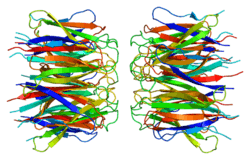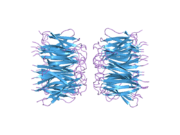NPM1
Nucleophosmin (NPM), also known as nucleolar phosphoprotein B23 or numatrin, is a protein that in humans is encoded by the NPM1 gene.[4][5]
Function
NPM1 is associated with nucleolar ribonucleoprotein structures and binds single-stranded and double-stranded nucleic acids, but it binds preferentially G-quadruplex forming nucleic acids. It is involved in the biogenesis of ribosomes and may assist small basic proteins in their transport to the nucleolus. Its regulation through SUMOylation (by SENP3 and SENP5) is another facet of the protein's regulation and cellular functions.
It is located in the nucleolus, but it can be translocated to the nucleoplasm in case of serum starvation or treatment with anticancer drugs. The protein is phosphorylated.
Nucleophosmin has multiple functions:[6]
- Histone chaperones
- Ribosome biogenesis and transport
- Genomic stability and DNA repair
- Endoribonuclease activity
- Centrosome duplication during cell cycle
- Regulation of ARF-p53 tumor suppressor pathway
- RNA helix destabilizing activity
- Inhibition of caspase-activated DNase
- Prevents apoptosis when located in nucleolus
Clinical significance
NPM1 gene is up-regulated, mutated and chromosomally translocated in many tumor types. Chromosomal aberrations involving NPM1 were found in patients with non-Hodgkin lymphoma, acute promyelocytic leukemia, myelodysplastic syndrome, and acute myelogenous leukemia.[7] Heterozygous mice for NPM1 are vulnerable to tumor development. In solid tumors NPM1 is frequently found overexpressed, and it is thought that NPM1 could promote tumor growth by inactivation of the tumor suppressor p53/ARF pathway; on the contrary, when expressed at low levels, NPM1 could suppress tumor growth by the inhibition of centrosome duplication.
Of high importance is NPM involvement in acute myelogenous leukemia,[8] where a mutated protein lacking a folded C-terminal domain (NPM1c+) has been found in the cytoplasm in patients. This aberrant localization has been linked to the development of the disease, and is associated with improved clinical outcomes. Strategies against this subtype of acute myelogenous leukemia include the refolding of the C-terminal domain using pharmalogical chaperones and the displacement of the protein from nucleolus to nucleoplasm, which has been linked to apoptotic mechanisms. It has also been shown that in the context of clonal hematopoiesis of undetermined significance harboring a DNMT3A mutation, subsequent NPM1 mutations drive progression into overt myeloproliferative neoplasm.[9]
Interactions
NPM1 has been shown to interact with
Nucleophosmin has multiple binding partners:[6]
- rRNA
- HIV Rev and Rex peptide
- p53 tumor suppressor
- ARF tumor suppressor
- MDM2 (mouse double minute 2, ubiquitin ligase)
- Ribosome protein S9
- Phosphatidylinositol 3,4,5-triphosphate (PIP3)
- Exportin-1 (CRM1, chromosome region maintenance)
- Nucleolin/C23
- Transcription target of myc oncogene
References
- GRCh38: Ensembl release 89: ENSG00000181163 - Ensembl, May 2017
- "Human PubMed Reference:". National Center for Biotechnology Information, U.S. National Library of Medicine.
- "Mouse PubMed Reference:". National Center for Biotechnology Information, U.S. National Library of Medicine.
- Liu QR, Chan PK (March 1993). "Characterization of seven processed pseudogenes of nucleophosmin/B23 in the human genome". DNA and Cell Biology. 12 (2): 149–56. doi:10.1089/dna.1993.12.149. PMID 8471164.
- Morris SW, Kirstein MN, Valentine MB, Dittmer KG, Shapiro DN, Saltman DL, Look AT (March 1994). "Fusion of a kinase gene, ALK, to a nucleolar protein gene, NPM, in non-Hodgkin's lymphoma". Science. 263 (5151): 1281–4. Bibcode:1994Sci...263.1281M. doi:10.1126/science.8122112. PMID 8122112.
- Lindström MS (2011). "NPM1/B23: A Multifunctional Chaperone in Ribosome Biogenesis and Chromatin Remodeling". Biochemistry Research International. 2011: 1–16. doi:10.1155/2011/195209. PMC 2989734. PMID 21152184.
- Falini B, Nicoletti I, Bolli N, Martelli MP, Liso A, Gorello P, Mandelli F, Mecucci C, Martelli MF (April 2007). "Translocations and mutations involving the nucleophosmin (NPM1) gene in lymphomas and leukemias" (PDF). Haematologica. 92 (4): 519–32. doi:10.3324/haematol.11007. PMID 17488663.
- Meani N, Alcalay M (September 2009). "Role of nucleophosmin in acute myeloid leukemia". Expert Review of Anticancer Therapy. 9 (9): 1283–94. doi:10.1586/era.09.84. PMID 19761432.
- Loberg MA, Bell RK, Goodwin LO, Eudy E, Miles LA, SanMiguel JM, Young K, Bergstrom DE, Levine RL, Schneider RK, Trowbridge JJ (January 2019). "Sequentially inducible mouse models reveal that Npm1 mutation causes malignant transformation of Dnmt3a-mutant clonal hematopoiesis". Leukemia. 33 (7): 1635–1649. doi:10.1038/s41375-018-0368-6. PMC 6609470. PMID 30692594.
- Lee SB, Xuan Nguyen TL, Choi JW, Lee KH, Cho SW, Liu Z, Ye K, Bae SS, Ahn JY (October 2008). "Nuclear Akt interacts with B23/NPM and protects it from proteolytic cleavage, enhancing cell survival". Proceedings of the National Academy of Sciences of the United States of America. 105 (43): 16584–9. Bibcode:2008PNAS..10516584L. doi:10.1073/pnas.0807668105. PMC 2569968. PMID 18931307.
- Sato K, Hayami R, Wu W, Nishikawa T, Nishikawa H, Okuda Y, Ogata H, Fukuda M, Ohta T (July 2004). "Nucleophosmin/B23 is a candidate substrate for the BRCA1-BARD1 ubiquitin ligase". The Journal of Biological Chemistry. 279 (30): 30919–22. doi:10.1074/jbc.C400169200. PMID 15184379.
- Li YP, Busch RK, Valdez BC, Busch H (April 1996). "C23 interacts with B23, a putative nucleolar-localization-signal-binding protein". European Journal of Biochemistry. 237 (1): 153–8. doi:10.1111/j.1432-1033.1996.0153n.x. PMID 8620867.
Further reading
- Yun C, Wang Y, Mukhopadhyay D, Backlund P, Kolli N, Yergey A, Wilkinson KD, Dasso M (November 2008). "Nucleolar protein B23/nucleophosmin regulates the vertebrate SUMO pathway through SENP3 and SENP5 proteases". The Journal of Cell Biology. 183 (4): 589–95. doi:10.1083/jcb.200807185. PMC 2582899. PMID 19015314.
- Haindl M, Harasim T, Eick D, Muller S (March 2008). "The nucleolar SUMO-specific protease SENP3 reverses SUMO modification of nucleophosmin and is required for rRNA processing". EMBO Reports. 9 (3): 273–9. doi:10.1038/embor.2008.3. PMC 2267381. PMID 18259216.
- Li L, Li HS, Pauza CD, Bukrinsky M, Zhao RY (2006). "Roles of HIV-1 auxiliary proteins in viral pathogenesis and host-pathogen interactions". Cell Research. 15 (11–12): 923–34. doi:10.1038/sj.cr.7290370. PMID 16354571.
- Gjerset RA (September 2006). "DNA damage, p14ARF, nucleophosmin (NPM/B23), and cancer". Journal of Molecular Histology. 37 (5–7): 239–51. doi:10.1007/s10735-006-9040-y. PMID 16855788.
- Chen W, Rassidakis GZ, Medeiros LJ (November 2006). "Nucleophosmin gene mutations in acute myeloid leukemia". Archives of Pathology & Laboratory Medicine. 130 (11): 1687–92. doi:10.1043/1543-2165(2006)130[1687:NGMIAM]2.0.CO;2 (inactive 2020-01-22). PMID 17076533.
- Falini B, Nicoletti I, Bolli N, Martelli MP, Liso A, Gorello P, Mandelli F, Mecucci C, Martelli MF (April 2007). "Translocations and mutations involving the nucleophosmin (NPM1) gene in lymphomas and leukemias" (PDF). Haematologica. 92 (4): 519–32. doi:10.3324/haematol.11007. PMID 17488663.
- Fankhauser C, Izaurralde E, Adachi Y, Wingfield P, Laemmli UK (May 1991). "Specific complex of human immunodeficiency virus type 1 rev and nucleolar B23 proteins: dissociation by the Rev response element". Molecular and Cellular Biology. 11 (5): 2567–75. doi:10.1128/MCB.11.5.2567. PMC 360026. PMID 2017166.
- Venkatesh LK, Mohammed S, Chinnadurai G (May 1990). "Functional domains of the HIV-1 rev gene required for trans-regulation and subcellular localization". Virology. 176 (1): 39–47. doi:10.1016/0042-6822(90)90228-J. PMID 2109912.
- Cochrane AW, Perkins A, Rosen CA (February 1990). "Identification of sequences important in the nucleolar localization of human immunodeficiency virus Rev: relevance of nucleolar localization to function". Journal of Virology. 64 (2): 881–5. doi:10.1128/JVI.64.2.881-885.1990. PMC 249184. PMID 2404140.
- Chan PK, Chan WY, Yung BY, Cook RG, Aldrich MB, Ku D, Goldknopf IL, Busch H (October 1986). "Amino acid sequence of a specific antigenic peptide of protein B23". The Journal of Biological Chemistry. 261 (30): 14335–41. PMID 2429957.
- Zhang XX, Thomis DC, Samuel CE (October 1989). "Isolation and characterization of a molecular cDNA clone of a human mRNA from interferon-treated cells encoding nucleolar protein B23, numatrin". Biochemical and Biophysical Research Communications. 164 (1): 176–84. doi:10.1016/0006-291X(89)91699-9. PMID 2478125.
- Hale TK, Mansfield BC (December 1989). "Nucleotide sequence of a cDNA clone representing a third allele of human protein B23". Nucleic Acids Research. 17 (23): 10112. PMC 335249. PMID 2602120.
- Chan WY, Liu QR, Borjigin J, Busch H, Rennert OM, Tease LA, Chan PK (February 1989). "Characterization of the cDNA encoding human nucleophosmin and studies of its role in normal and abnormal growth". Biochemistry. 28 (3): 1033–9. doi:10.1021/bi00429a017. PMID 2713355.
- Li XZ, McNeilage LJ, Whittingham S (August 1989). "The nucleotide sequence of a human cDNA encoding the highly conserved nucleolar phosphoprotein B23". Biochemical and Biophysical Research Communications. 163 (1): 72–8. doi:10.1016/0006-291X(89)92100-1. PMID 2775293.
- Chan PK, Aldrich M, Cook RG, Busch H (February 1986). "Amino acid sequence of protein B23 phosphorylation site". The Journal of Biological Chemistry. 261 (4): 1868–72. PMID 3944116.
- Bocker T, Bittinger A, Wieland W, Buettner R, Fauser G, Hofstaedter F, Rüschoff J (April 1995). "In vitro and ex vivo expression of nucleolar proteins B23 and p120 in benign and malignant epithelial lesions of the prostate". Modern Pathology. 8 (3): 226–31. PMID 7542384.
- Dundr M, Leno GH, Hammarskjöld ML, Rekosh D, Helga-Maria C, Olson MO (August 1995). "The roles of nucleolar structure and function in the subcellular location of the HIV-1 Rev protein". Journal of Cell Science. 108 ( Pt 8) (8): 2811–23. PMID 7593322.
- Miyazaki Y, Takamatsu T, Nosaka T, Fujita S, Martin TE, Hatanaka M (July 1995). "The cytotoxicity of human immunodeficiency virus type 1 Rev: implications for its interaction with the nucleolar protein B23". Experimental Cell Research. 219 (1): 93–101. doi:10.1006/excr.1995.1209. PMID 7628555.
- Szebeni A, Herrera JE, Olson MO (June 1995). "Interaction of nucleolar protein B23 with peptides related to nuclear localization signals". Biochemistry. 34 (25): 8037–42. doi:10.1021/bi00025a009. PMID 7794916.
- Kato S, Sekine S, Oh SW, Kim NS, Umezawa Y, Abe N, Yokoyama-Kobayashi M, Aoki T (December 1994). "Construction of a human full-length cDNA bank". Gene. 150 (2): 243–50. doi:10.1016/0378-1119(94)90433-2. PMID 7821789.
- Marasco WA, Szilvay AM, Kalland KH, Helland DG, Reyes HM, Walter RJ (1995). "Spatial association of HIV-1 tat protein and the nucleolar transport protein B23 in stably transfected Jurkat T-cells". Archives of Virology. 139 (1–2): 133–54. doi:10.1007/BF01309460. PMID 7826206.
- Valdez BC, Perlaky L, Henning D, Saijo Y, Chan PK, Busch H (September 1994). "Identification of the nuclear and nucleolar localization signals of the protein p120. Interaction with translocation protein B23". The Journal of Biological Chemistry. 269 (38): 23776–83. PMID 8089149.




